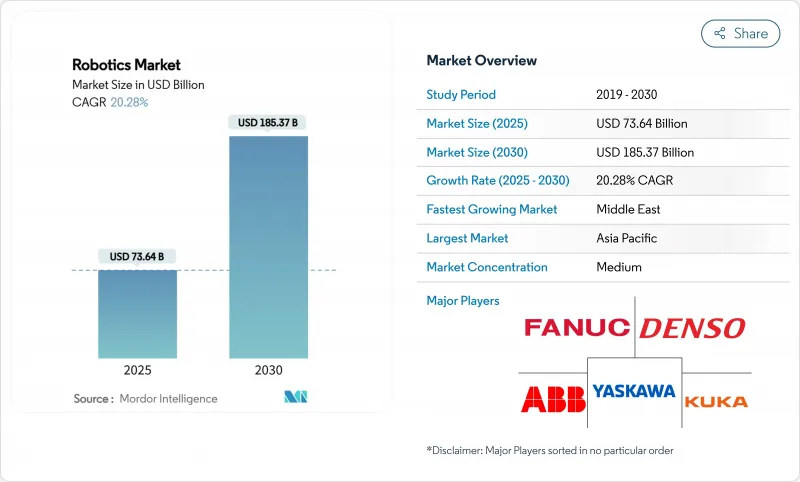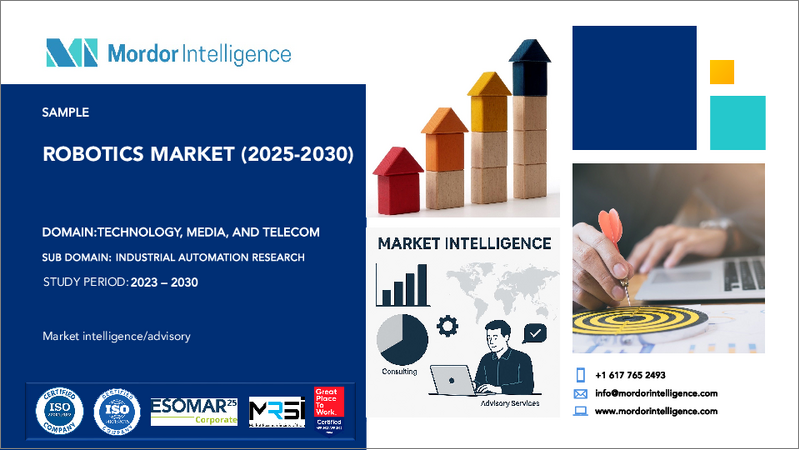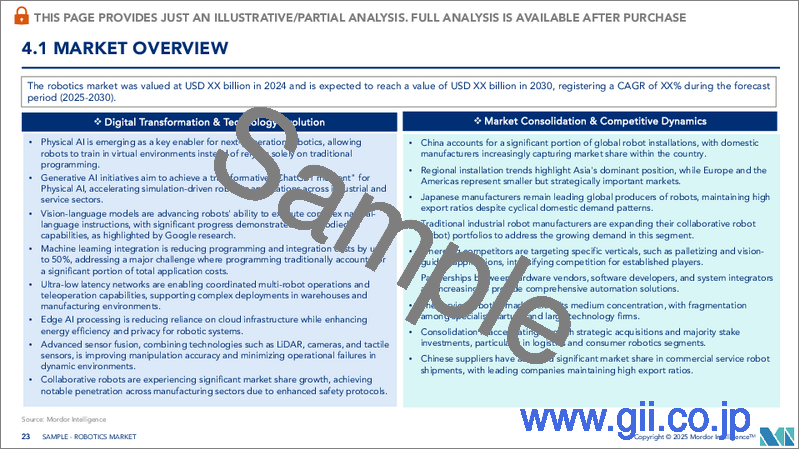|
|
市場調査レポート
商品コード
1851239
ロボティクス:市場シェア分析、産業動向、統計、成長予測(2025年~2030年)Robotics - Market Share Analysis, Industry Trends & Statistics, Growth Forecasts (2025 - 2030) |
||||||
カスタマイズ可能
適宜更新あり
|
|||||||
| ロボティクス:市場シェア分析、産業動向、統計、成長予測(2025年~2030年) |
|
出版日: 2025年07月11日
発行: Mordor Intelligence
ページ情報: 英文 210 Pages
納期: 2~3営業日
|
概要
ロボティクスの世界市場は、2025年に736億4,000万米ドルに達し、2030年には1,853億7,000万米ドルに拡大すると予測されています。

この成長軌道は、先進国における構造的な労働力不足、自動化ハードウェアの体系的なコスト・デフレ、およびロボットをオプションの資本財ではなく戦略的インフラとして扱う政府支援の再ショアリング・プログラムを反映しています。大企業は賃金上昇圧力の中で生産を安定させるために導入を加速させ、中小企業は協働システムやRAS契約を通じてロボットにアクセスするようになっています。地域別の勢いは変化している:アジア太平洋地域は引き続き台数でリードしているが、政府系ファンドがテクノロジー主導の多様化を追求しているため、中東が最も速いペースを示しています。供給側では、部品コストの低下とローコード・プログラミング・プラットフォームによってバリューチェーンがソフトウェア・インテリジェンスへと再構築され、人工知能ベースの制御を得意とするベンダーにとっては定期的な収益源が確立されます。サイバーセキュリティの弱点、輸出管理上の摩擦、小規模ユーザー間のスキル格差は、依然としてブレーキとなる要因であるが、特に安全な配備とライフサイクル・サポートにおいて、専門家によるサービスのニッチも開いています。
世界のロボティクス市場の動向と洞察
労働力不足による自動化需要の増加
日本、米国、西欧の大部分では、人口動態の逆風により、自動化がコスト削減から生産能力確保へとシフトしています。2024年には、G7製造業全体で工場の未充足人員は200万人を超え、日本のロボット密度は従業員1万人当たり399台に達し、過去最高となりました。ステランティスのような自動車メーカーは、反復疲労による怪我を減らしながらも従業員数を確保する、人間中心のロボットセルを採用し、協働配置への微妙な後押しを示しています。世界のロボティクス市場が恩恵を受けるのは、こうした構造的なギャップが景気サイクルを通じて持続し、GDPの変動から切り離された予測可能な需要基盤をベンダーに与えるからです。
機能時間当たりの平均ロボット価格の低下
コンポーネントのコモディティ化と大規模生産により、協働ロボットの価格は2024年以降、年率約15%削減される一方、ソフトウェアのアップグレードにより、価格に対する性能は倍増します。中国のサプライヤーはエントリーレベルのヒューマノイドを19万9,000人民元(2万7,512米ドル)で販売し、ロボットを小規模工場の資本予算の範囲内に収めました。ハードウェアのコストが低下するにつれて、小規模メーカーや新興市場メーカーの間で採用曲線が急勾配になり、その結果、世界のロボティクス市場の対応可能プールが拡大します。
根強い中小企業の統合スキル・ギャップ
中小企業の68%は、ロボティクス導入に必要なエンジニアの人材が不足しており、投資回収期間が長期化し、利用率が低下しています。インテグレーターは都市部に集中しており、地方の企業は十分なサービスを受けていないです。スキル開拓の促進やターンキーサービスモデルがなければ、世界のロボティクス市場にはかなりの潜在需要が未開拓のまま残されています。
セグメント分析
2024年のロボティクス世界市場の71.4%は産業用ロボットであり、自動車や電子機器の高スループット組立ラインからの持続的な需要に支えられています。しかし、協働作用ロボットは2030年までCAGR 26.71%で拡大し、安全認証を取得したフォースセンシングと中小企業の予算内に収まる3万米ドル以下の価格設定に支えられています。この軸足は、柵で囲まれたラインではなく、人間が監督する柔軟なセルが、世界のロボティクス市場の次の展開の波を牽引することを示唆しています。
中国のコボットメーカーの急増により、2017年から2024年の間に国内シェアが35%から73%に上昇し、価格競争が激化し、世界的な台数の伸びが加速しています。外科手術システムは2024年に39億2,000万米ドルを超え、ヘルスケアが最も急成長している最終用途であることが再確認されました。このような多様化により、世界のロボティクス市場の周期性は緩和され、ハードウェアベンダーは単一セクターの不況に備えることができます。
ハードウェアは2024年の支出額の63.8%を占めるが、人工知能が主要な価値ドライバーとなるため、ソフトウェア収入は毎年23.62%成長します。ABBのOmniCoreプラットフォームでは、より高度な制御スタックにクラウド・アナリティクスと強化学習が組み込まれ、サイクルタイムを25%高速化し、電力使用量を20%削減しています。サブスクリプションベースのRobot-as-a-Serviceの世界市場規模は、顧客が資本支出から運用支出モデルに移行するにつれて、2030年までに3倍に拡大すると予測されます。
統合、遠隔監視、予知保全をカバーするサービス収益は、ベンダーの囲い込みをさらに強固にします。その結果、ソフトウェアとサービスが曖昧になり、アップデート権やサイバーセキュリティパッチが複数年契約に組み込まれます。この動向は、世界のロボティクス市場において、利益プールを再構築し、純粋にハードウェア中心の課題者の参入障壁を高めています。
地域分析
アジア太平洋地域は、2024年に世界のロボティクス市場シェアの38.1%を確保し、中国の年間43万台の産業用ロボット設置台数と世界のロボティクス特許付与数の3分の2を占める。中国の工場はロボットをリチウムイオン電池や家電製品ラインに統合し、国内ブランドは輸出を拡大し、地域のコスト競争力を世界のロボティクス市場に定着させる。日本は、中国需要の復活と国内人口動態の圧力により、2024年にファナックで1,802億円(16億4,000万米ドル)の利益を計上。韓国の26億米ドルの官民プログラムは、ヒューマノイドの専門知識をバッテリー工場の自動化に振り向け、戦略的優先順位を明確にしました。
中東は、炭化水素の余剰を産業デジタル化、ロジスティクス、ヘルスケアに振り向ける政府系ファンドにより、2030年までのCAGRが21.84%と最も高いです。アラブ首長国連邦の自由貿易区では、地域のeコマースの流れに対応するため、倉庫型AMRを試験的に導入し、季節的移民労働への過度の依存を減らしています。国家プログラムはさらに、グローバルインテグレーターを惹きつける先端製造ハブに資金を提供し、世界のロボティクス市場の対応可能ベースを拡大します。
北米の需要は引き続き底堅く、CHIPS-Actに支援されたファブや、Andurilが海軍から6億4,220万米ドルの対ドローンを受注したような防衛契約に後押しされています。欧州は、人間とロボットの安全な協働基準と持続可能性目標に注力しており、ドイツの人工知能統合に対する年間6,900万ユーロ(7,500万米ドル)の資金援助が後押ししています。両地域とも、高価値のソフトウェアと統合に投資する一方で、汎用サブアセンブリーのアジアへの外注を増やしており、これは世界のロボティクス市場におけるバーベル戦略を反映しています。
その他の特典:
- エクセル形式の市場予測(ME)シート
- 3ヶ月間のアナリストサポート
よくあるご質問
目次
第1章 イントロダクション
- 調査の前提条件と市場の定義
- 調査範囲
第2章 調査手法
第3章 エグゼクティブサマリー
第4章 市場情勢
- 市場概要
- 市場促進要因
- 労働力不足による自動化需要の高まり
- 機能時間当たりの平均ロボット価格の低下
- ローコード・ロボット・プログラミング・プラットフォームの普及
- G7における製造業のリショアリングに対する財政的インセンティブ
- eコマース3PLによる倉庫AMRの展開
- 国家レベルのヒューマノイドRandDミッション(中国2025など)
- 市場抑制要因
- 根強い中小企業の統合スキル格差
- 先進サーボの地政学的輸出規制
- レアアース磁石の価格変動
- ROS導入におけるサイバーセキュリティの脆弱性
- バリューチェーン分析
- 規制情勢
- テクノロジーの展望
- ポーターのファイブフォース分析
- 新規参入業者の脅威
- 供給企業の交渉力
- 買い手の交渉力
- 代替品の脅威
- 競争企業間の敵対関係
- 市場のマクロ経済動向の評価
第5章 市場規模と成長予測
- ロボットタイプ別
- 産業用ロボット
- サービスロボット
- 共同作業(コボット)
- モバイル/AMR
- コンポーネント別
- ハードウェア
- ソフトウェア
- サービス(インテグレーション、RaaS)
- 用途別
- 製造および組立
- 物流・倉庫
- 医療・外科
- 防衛と安全保障
- 検査とメンテナンス
- クリーニングとサニテーション
- エンドユーザー業界別
- 自動車
- エレクトロニクスと半導体
- 飲食品
- ヘルスケアプロバイダー
- 軍事・防衛
- その他のエンドユーザー産業
- 地域別
- 北米
- 米国
- カナダ
- メキシコ
- 欧州
- ドイツ
- 英国
- フランス
- その他欧州地域
- アジア太平洋地域
- 中国
- インド
- 日本
- その他アジア太平洋地域
- 南米
- ブラジル
- アルゼンチン
- その他南米
- 中東
- アラブ首長国連邦
- サウジアラビア
- その他中東
- アフリカ
- 南アフリカ
- ナイジェリア
- その他アフリカ
- 北米
第6章 競合情勢
- 市場集中度
- 戦略的動向
- 市場シェア分析
- 企業プロファイル
- ABB Ltd.
- Fanuc Corporation
- Yaskawa Electric Corporation
- KUKA AG
- Kawasaki Heavy Industries Ltd
- Universal Robots A/S(Teradyne)
- Denso Corporation
- Mitsubishi Electric Corporation
- Omron Corporation
- Staubli International AG
- Epson Robots(Seiko Epson)
- Comau SpA
- Nachi-Fujikoshi Corp.
- Toshiba Corporation
- Intuitive Surgical Inc.
- Stryker Corporation
- iRobot Corporation
- Boston Dynamics Inc.
- Locus Robotics Corp.
- DJI Technology Co. Ltd





